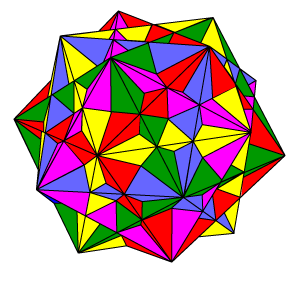|
FIVE CUBES COMPOUND
We have already seen how it is possible to inscribe a cube inside a dodecahedron, using eight of the vertices of the dodecahedron. In fact it is possible to inscribe five different cubes to form a the complicated but pretty compound shown. Five cubes have 40 vertices; a dodecahedron has 20 vertices. Hence using the symmetry of the compound, each vertex of the dodecahedron occurs as the vertex of two of the cubes. Because of the complexity of this compound, it is better to simply enjoy it, rather than analyzing it too deeply. However, we note that the edges of the cubes lie by fives on the faces of the underlying dodecahedron forming regular pentagrams. This means that each edge is divided by two other edges in golden section. View this structure. We can break the model down into its five component cubes. Another way of viewing the compound is to remove the cubes one by one: We can define a unique rhombus with each of the faces of each of the cubes. For example, consider the blue cube in the adjacent figure, and the upward/left facing face. As noted above, faces of the other four cubes intersect the edges of the blue cube face in the face vertices and at pairs of points on each face edge (which in fact divide the edge in the golden ratio). If we draw in the lines where the faces meet (vertex to furthest opposite golden point), a rhombus is determined. Since the five cubes each have six faces, there are 30 such rhombuses. These form a polyhedron known as a rhombic tricontahedron, (below) which is the solid intersection of points common to all the five cubes. Click the figure at right to restore the original.
This is one of the more difficult polyhedral models you may try to make. A cut-out model is available through Tarquin publications (see references below). Alternatively, detailed nets are available on the site by Gijs Korthals Altes, or here. Otherwise, you can make your own model directly using the guide given in Cundy and Rollett or Math World (both below). You will need a lot of perseverance! There seems little pint in reproducing the complicated nets here. For some reason, this model appears to be omitted from Wenninger’s Polyhedral Models (at least in my edition).
It is profitable to spend some time playing with the applet, and enjoying this beautiful compound polyhedron. Use the applet to check out the following statements:
When we looked at the dodecahedron, we discovered that we can take as coordinates for the 20 vertices: (
• (a) Try to find the coordinates of the remaining four cubes. To help, you might ask: what is the side length of each cube? We also know that each of the vertices of the given cube is a vertex of another cube as well. So, why not start by looking at
(
The given cube is symmetric about the origin. Since the cubes have side length 2, the major diagonals of each cube will have length Noting that the distance between
s2 = 1 + (1 + It follows that vertices
If you feel unsure about our assertions, you can check the distances between each pair of vertices of the cube. Similar calculations now give the vertex sets of the remaining three cubes:
In fact, the five cubes are given by the initial cube, and the five rotations through 2 There are of course other vertices occurring within this compound; for example the two golden section points on each edge of each cube. References MathWorld: http://mathworld.wolfram.com/Cube5-Compound.html Cundy, H. M., Rollett, A. P., Mathematical Models, Oxford (2nd Edition 1961), Various compounds of cubes Tarquin model: http://www.tarquin-books.demon.co.uk/form/tarquinlatestnew.html Construction net: http://www.sectormatematica.cl/Regalos/poliedros.pdf |
We obtain the above results by looking straight down on the model with a vertex of
(a) the octahedron and
(b) a vertex of the cube closest to the eye.
Obtaining these numbers is getting a little more tricky. |
